For tribes, 'good fire' a key to restoring nature and people
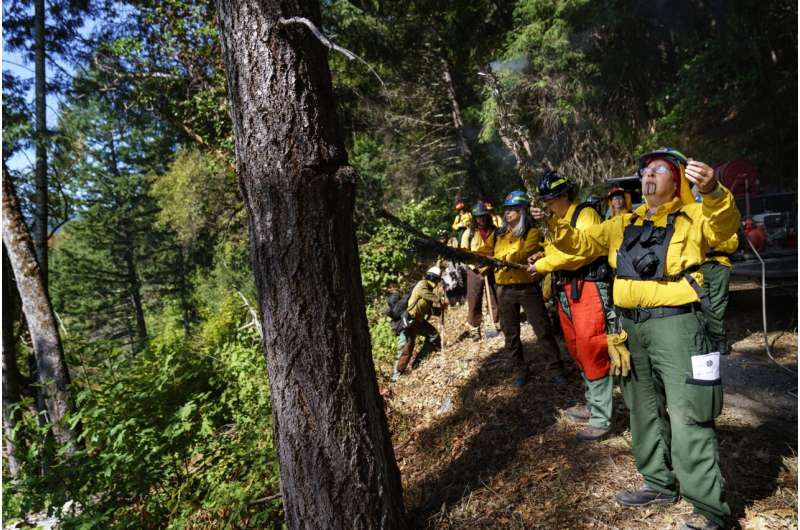
Elizabeth Azzuz stood in prayer on a Northern California mountainside, arms outstretched, grasping a handmade torch of dried wormwood branches, the fuel her Native American ancestors used for generations to burn underbrush in thick forest.
"Guide our hands as we bring fire back to the land," she intoned before crouching and igniting dead leaves and needles carpeting the ground.
Others joined her. And soon dancing flames and pungent smoke rose from the slope high above the distant Klamath River.
Over several days in early October, about 80 acres (32.4 hectares) on the Yurok reservation would be set aflame. The burning was monitored by crews wearing protective helmets and clothing—firefighting gear and water trucks ready. They were part of a program that teaches Yurok and other tribes the ancient skills of treating land with fire.
Such an act could have meant jail a century ago. But state and federal agencies that long banned "cultural burns" in the U.S. West are coming to terms with them—and even collaborating—as the wildfire crisis worsens.
Wildfires have blackened nearly 6,000 square miles (15,540 square kilometers) in California the past two years and more elsewhere amid prolonged drought and rising temperatures linked to climate change. Dozens have died; thousands of homes have been lost.
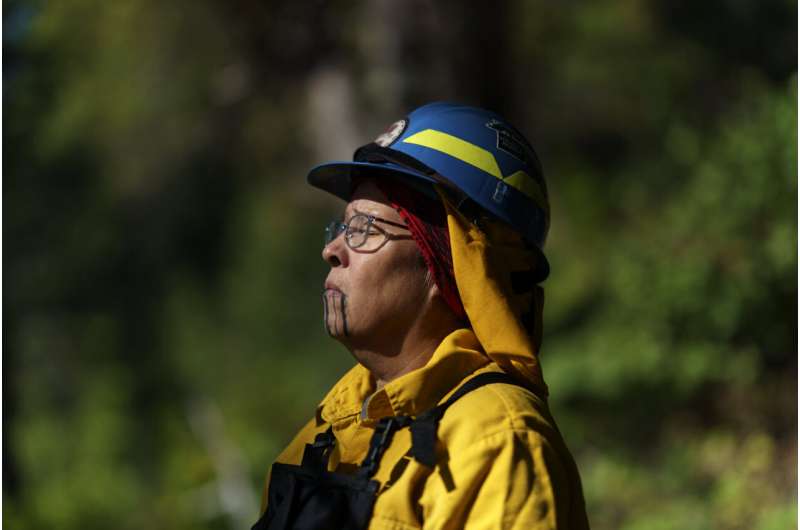
Scientific research increasingly confirms what tribes argued all along: Low-intensity burns on designated parcels, under the right conditions, reduce the risk by consuming dead wood and other fire fuels on forest floors.
To the Yurok, Karuk and Hupa in the mid-Klamath region, the resurgence of cultural burning is about reclaiming a way of life violently suppressed with the arrival of white settlers in the 1800s.
Indigenous people had their land seized, and many were killed or forced onto reservations. Children were sent to schools that forbade their languages and customs. And their hunter-gatherer lifestyle was devastated by prohibitions on fire that tribes had used for thousands of years to treat the landscape.
It enriched the land with berries, medicinal herbs and tan oak acorns while killing bugs. It opened browsing space for deer and elk. It let more rainwater reach streams, boosting salmon numbers. It spurred hazelnut stems and bear grass used for intricate baskets and ceremonial regalia.
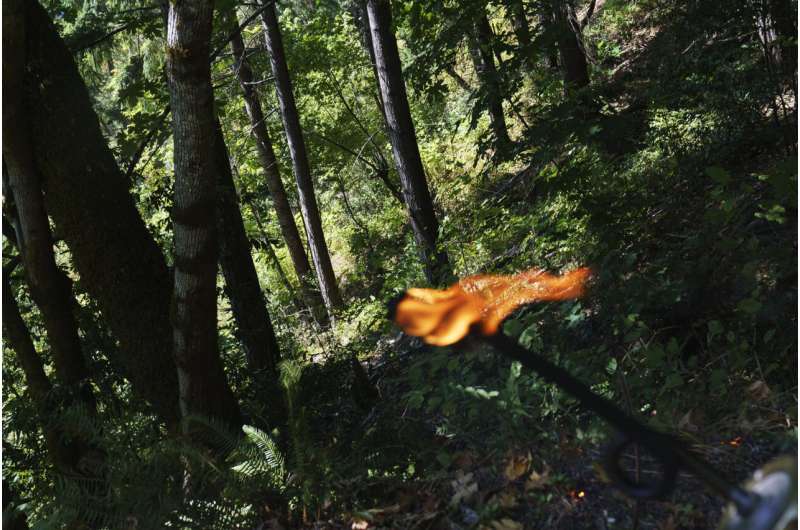
Now, descendants of those who quietly kept the old ways alive are practicing them openly, creating "good fire."
"Fire is a tool left by the Creator to restore our environment and the health of our people," said Azzuz, board secretary for the Cultural Fire Management Council, which promotes burning on ancestral Yurok lands.
"Fire is life for us."
PERSECUTION AND PERSEVERANCE
Nine years ago, Margo Robbins got a facial tattoo—two dark stripes from the edges of her mouth to below her chin, and another midway between them. It once was a common mark for Yurok women, including her great-grandmother.
"I got mine to represent my commitment to continuing the traditions of our ancestors," said Robbins, 59, whose jokes and cackling laugh mask a steely resolve.
She would become a leading voice in the struggle to return fire to her people's historical territory, much under state and federal management. The more than 5,000-member tribe's reservation courses along a 44-mile (70.8-kilometer) stretch of the Klamath.
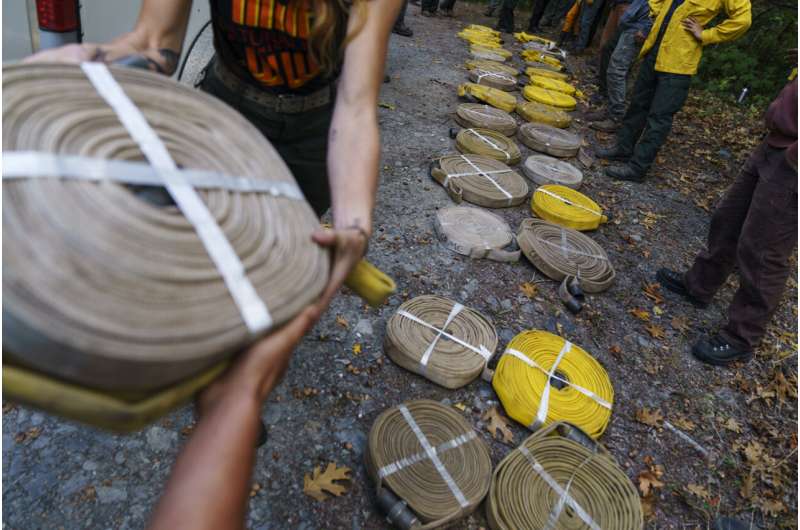
Since 1910, when infernos consumed more than 3 million (1.2 million hectares) western acres, federal policy had considered fire an enemy. "Only you can prevent forest fires," Smokey Bear later proclaimed in commercials.
"They considered tribal people arsonists, didn't understand the relationship between fires and a healthy forest," said Merv George, 48, a former Hoopa Valley Tribe chairman who now supervises Rogue River-Siskiyou National Forest in Northern California. "I heard stories of people getting thrown in jail if they were caught."
But when George joined the U.S. Forest Service as a tribal relations manager in 2008, western wildfires were growing bigger and more frequent; officials knew something needed to change.
Two national forests—Six Rivers and Klamath—joined a landscape restoration partnership with the Karuk tribe and nonprofit groups. It released a 2014 plan endorsing "prescribed," or intentional, burns.
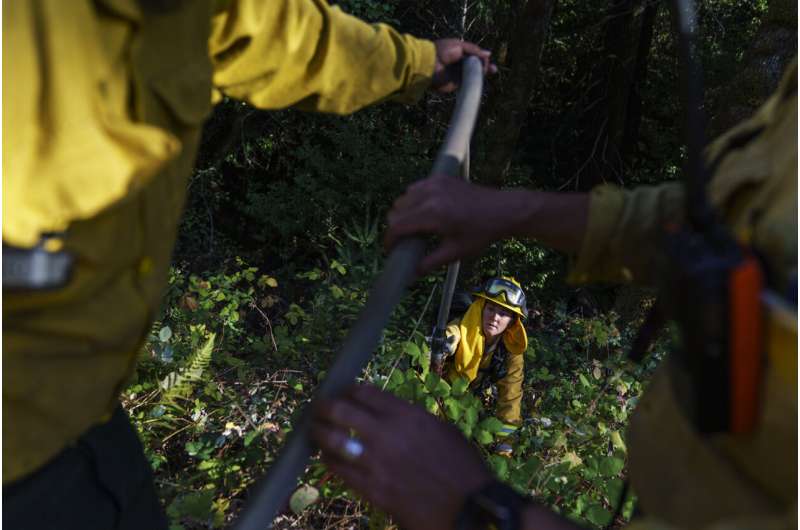
A year earlier, the California Department of Forestry and Fire Protection, or Cal Fire, had approved a small cultural burn on Yurok land.
It was a victory for Robbins. As a young girl of Yurok, Hupa and Irish descent, she learned the basketry fundamental to her native identity. Tribes use baskets for gathering food and medicinal plants, trapping eels, ceremonial dancing, cradling babies, even prayer.
"Weaving is really, really soothing. It's kind of like medicine for your soul," she said, displaying finely crafted baskets at a Yurok firehouse near the village of Weitchpec.
But weaving materials had become scarce, particularly hazel wood. Burns in bygone days helped the shoots grow straight and strong. Under no-fire management, hazel was stunted by shrubs, downed trees, matted leaves.
With grandchildren on the way, Robbins wanted them carried in traditional baby baskets. She needed tribal forests to produce high-quality hazel once more. That meant fire.
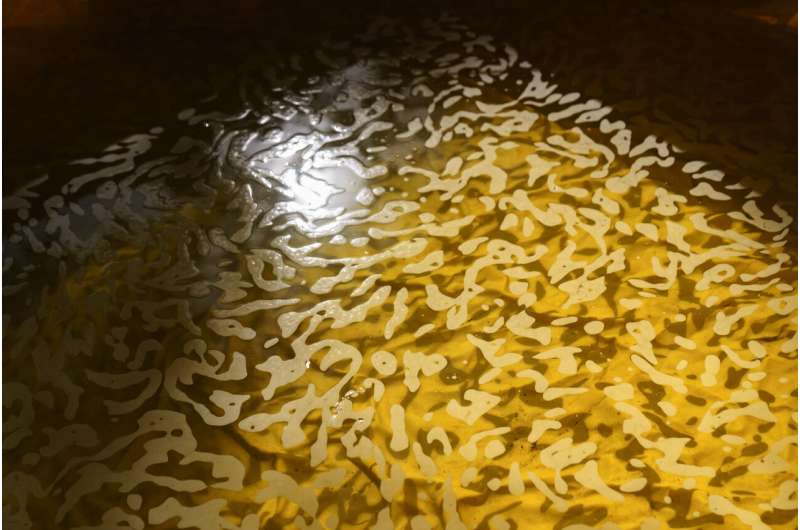
After the state-sanctioned Yurok small burn, Robbins and other community members established the Cultural Fire Management Council to push for more.
They allied with Karuk and Hupa activists and The Nature Conservancy to create the Indigenous Peoples Burning Network, which conducts training burns that have drawn hundreds of participants from across the U.S. and other countries. It has expanded into Oregon, Minnesota and New Mexico.
"It's really exciting and gives me a lot of hope that the tide is changing," Robbins said. "We revived our language, our dances, and now, bringing back fire, we'll restore the land."
'FINALLY BEING HEARD'
To prepare for the one this month in the Klamath region, Yurok leaders studied weather forecasts, scouted mountainous burn areas, positioned water tanks, uncoiled fire hoses, equipped and drilled 30-plus crew members.
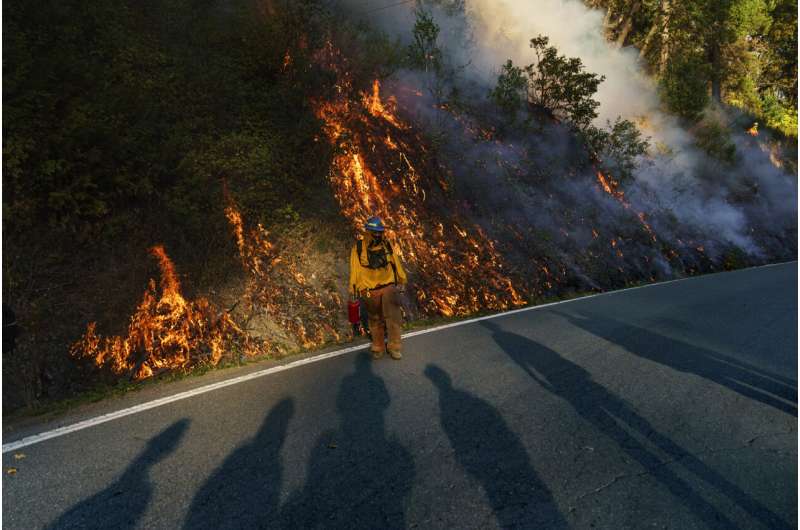
As Azzuz finished her ceremonial prayer, the wormwood that coaxed the first flames was replaced with modern "drip torches"—canisters of gasoline and diesel with spouts and wicks. Team members moved quickly along a dirt trail, flicking droplets of burning fuel.
Smoke billowed. Flames crackled and hissed. Tangles of green and brown foliage were reduced to ash. Young Douglas firs that squeeze out other species were another target.
But larger trees—oaks, madrones, conifers—were largely unscathed, aside from patches of scorched bark.
"It's beautiful and black," Azzuz exulted. "By next spring, there will be a lot of hazel shoots."
Hour by hour, torch bearers moved down the slope, igniting swaths of forest floor. Co-workers in radio contact watched firebreaks, ready to douse or beat down stray flames.
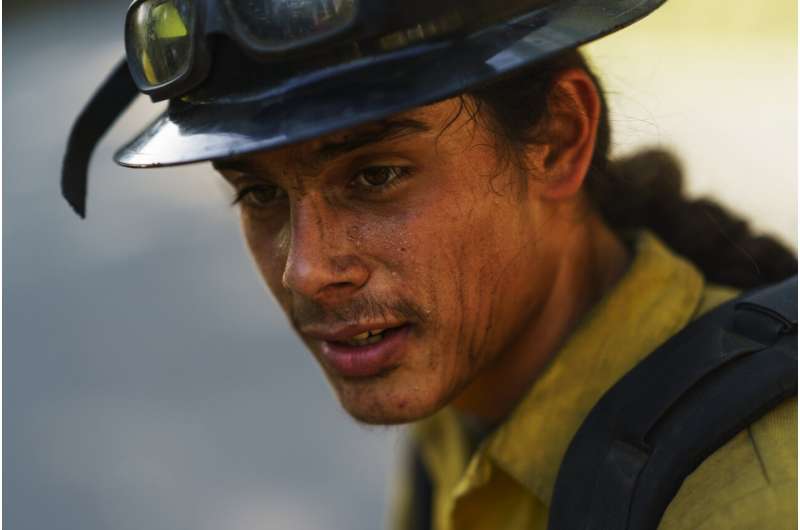
There were young and middle-aged, native and non-native, novices and veterans—some from area tribes, others from far away.
Jose Luis Dulce, a firefighter in his native Spain and Ecuador, said he wanted to help revive Indigenous techniques in Europe and South America. Stoney Timmons said his tribe—the Robinson Rancheria Pomo Indians of California—wants to host its own training session next year.
"I'm getting some good lessons to take back," Timmons said.
The exercise was especially satisfying for Robert McConnell Jr., who spent years with Forest Service wildfire crews, attacking from helicopters and driving bulldozers. Now a prescribed fire specialist with Six Rivers National Forest, he works with fire instead of against it.
"I get to feel like I'm Indian again when I get to burn," he said. "It's encoded in my DNA. It's like there's a spark in my eye when I see fire get put on the ground."
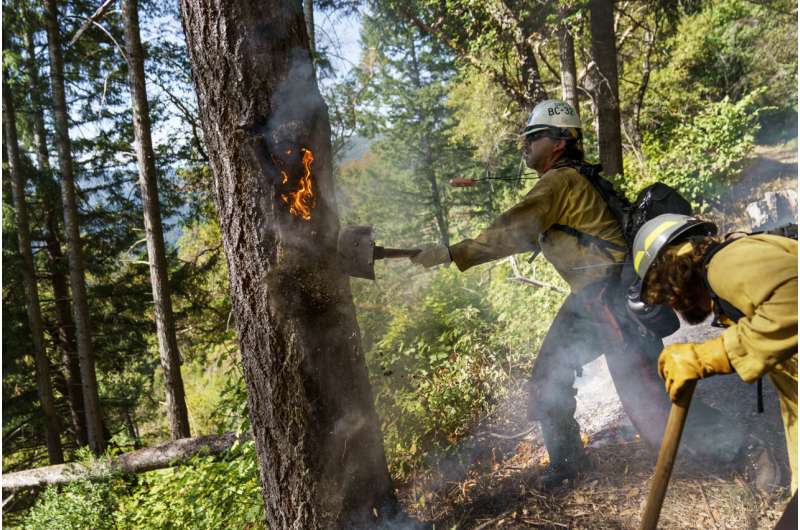
As shadows lengthened, cheery yips gave way to shrieks: "Log! Log!" A chunk of flaming timber jounced down a sharply angled slope, smacked onto a two-lane road and hurtled into a thicket below, igniting brush along the way.
Although crew members quickly extinguished the flames, the runaway log was a reminder of the job's hazards.
Nick Hillman, 18, his face glistening with grimy sweat, was unfazed. "I know my ancestors want me to be doing this," he said.
When Yurok forestry director Dawn Blake helped light the hillside, she felt a connection with her grandmother, who wove baskets and set fires in the area long ago.
"We've been talking and begging about doing this for so long, just spinning our wheels," said Blake, 49. "It feels like we're finally being heard."
BIGGER AMBITIONS
But tribes want to go beyond training exercises and "family burns" on small plots. They're pushing to operate throughout the vast territories their ancestors occupied.
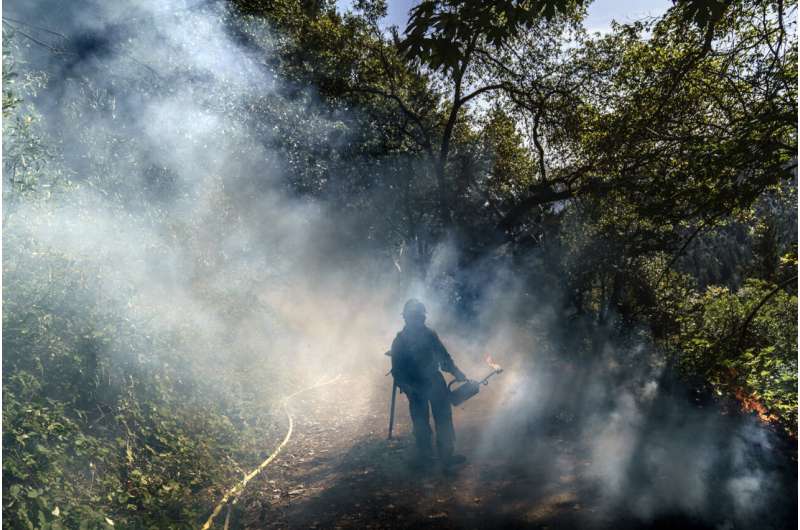
"My ultimate goal is to restore all this land back to a natural state," said Blaine McKinnon, battalion chief for the Yurok Fire Department and a leader of the recent cultural burn.
Relations with federal and state authorities have improved, but complaints persist about permits denied, burns postponed and heavy-handed oversight.
Cultural fire leaders say pledges of cooperation from agency higher-ups aren't always carried out by local officials, who fear dismissal if fires get out of hand.
It's a fair point, said Craig Tolmie, chief deputy director of Cal Fire, which struggles to balance the tribes' desires for more fire with opposition from a jittery public.
"People have really been traumatized and shocked by the last two fire seasons," Tolmie said.
Under state laws enacted this year, tribal burners and front-line regulators will work more closely, he said. One measure requires his department to appoint a cultural burning liaison and provide training and certification for prescribed fire "burn bosses."
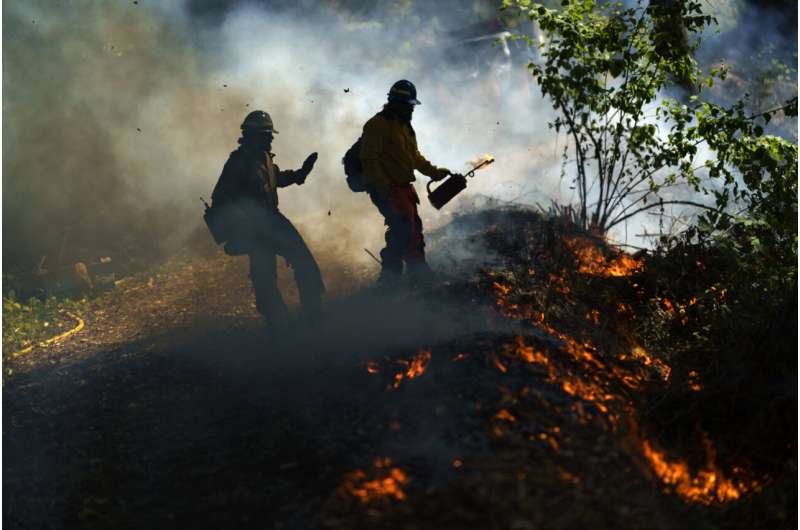
Another makes it easier to get liability insurance by raising the bar for requiring burn professionals to pay for extinguishing out-of-control fires—a rarity but always a risk. Lawmakers also budgeted $40 million for a prescribed fire insurance fund and tribal burn programs.
Still, prescribed burns alone can't rid forests of more than a century's accumulation of woody debris, Tolmie said, arguing that many areas should be "pre-treated" with mechanical grinding and tree thinning before fires are set.
Ancient wisdom and scientific research show otherwise, said Chad Hanson, forest ecologist with the John Muir Project of Earth Island Institute in California. Regulators are "trying to extort tribes" by making cultural burns contingent on logging, he said.
Bill Tripp, the Karuk tribe's natural resources director, said the solution is empowering tribes to handle prescribed burns while Cal Fire and the Forest Service focus on suppressing wildfires.
-
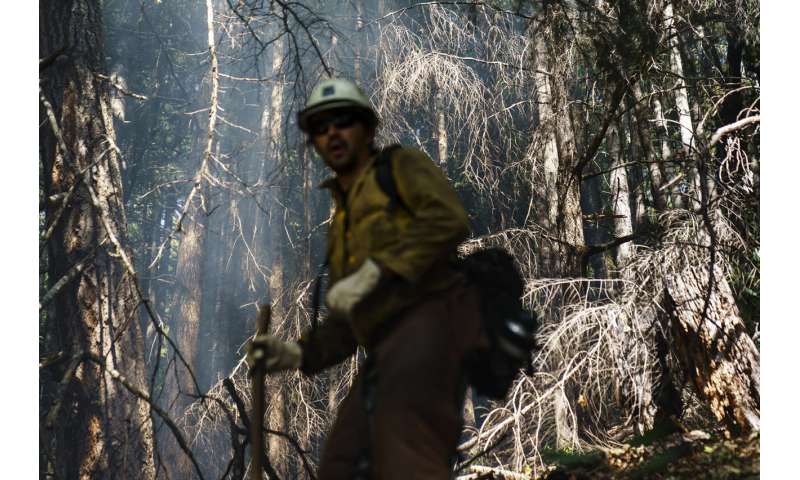
Robert McConnell Jr, a prescribed fire specialist with Six Rivers National Forest and a member of the Yurok tribe, watches for embers flying uphill from the cultural training burn area on the Yurok reservation in Weitchpec, Calif., Thursday, Oct. 7, 2021. The cultural training burn was part of a program that teaches younger Yurok and other tribes the ancient skills of treating land with fire. Credit: AP Photo/David Goldman -
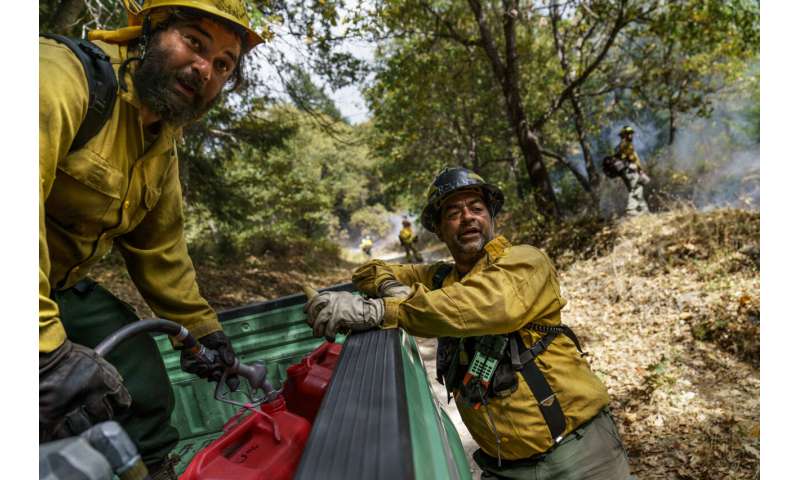
Raven Parkins, foreground center, a member of the Modoc tribe, and Max Brotman, left, fill gas canisters during a cultural training burn on the Yurok reservation in Weitchpec, Calif., Friday, Oct. 8, 2021. Hour by hour, torch bearers moved down the slope, igniting swaths of forest floor. Co-workers in radio contact watched firebreaks, ready to douse or beat down stray flames. Credit: AP Photo/David Goldman -
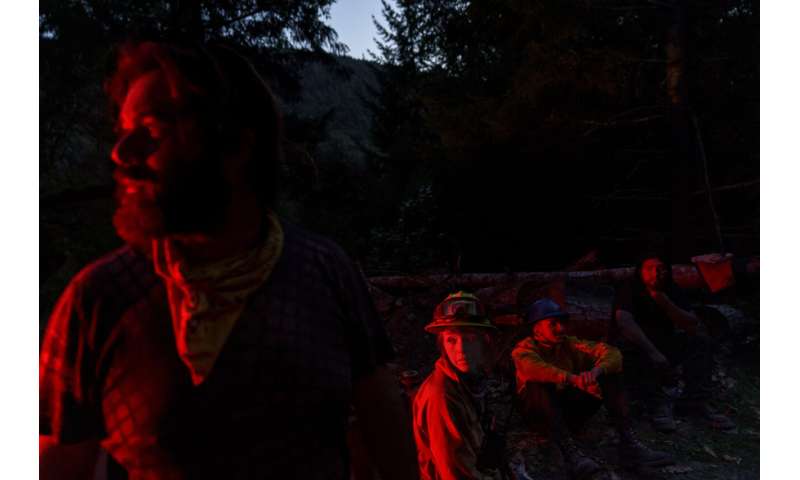
From left, Max Brotman and Rhodri Wiseman, rest along with Robinson Rancheria Pomo Indians Eric Timmons and his brother, Stoney Timmons, after they finished working a cultural training burn on the Yurok reservation in Weitchpec, Calif., Thursday, Oct. 7, 2021. Credit: AP Photo/David Goldman -
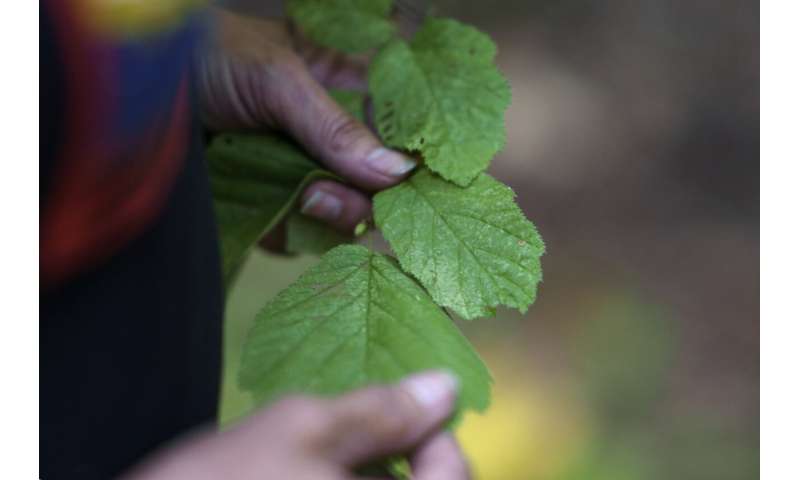
Margo Robbins, a member of the Yurok tribe, holds a hazel leaf while scouting an area before a cultural training burn on the Yurok reservation in Weitchpec, Calif., Tuesday, Oct. 5, 2021. Tribes like the Yurok use baskets for gathering food and medicinal plants, trapping eels, ceremonial dancing, cradling babies, even prayer. But weaving materials had become scarce, particularly hazel wood. Burns in bygone days helped the shoots grow straight and strong. Under no-fire management, hazel was stunted by shrubs, downed trees, matted leaves. Credit: AP Photo/David Goldman -
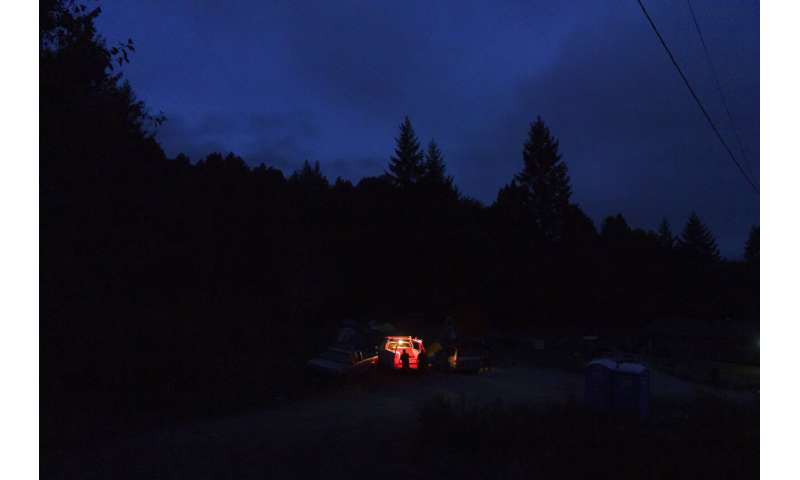
Marty Duncan, a member of the Robinson Rancheria Pomo Indians, prepares for a cultural training burn after waking up in a campsite in Weitchpec, Calif., Thursday, Oct. 7, 2021. Over several days in early October, about 80 acres (32 hectares) on the Yurok reservation would be set aflame. The burning was monitored by crews wearing protective helmets and clothing—firefighting gear and water trucks ready. They were part of a program that teaches younger Yurok and other tribes the ancient skills of treating land with fire. Credit: AP Photo/David Goldman -
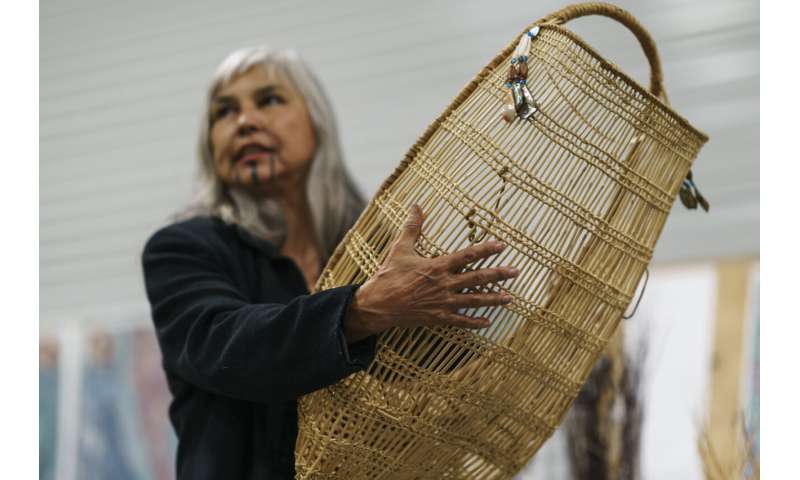
Margo Robbins shows off a baby basket she made out of hazel wood to participants of a cultural training burn on the Yurok reservation in Weitchpec, Calif., Thursday, Oct. 7, 2021. As a young girl of Yurok, Hupa and Irish descent, she learned the basketry fundamental to her native identity. Tribes use baskets for gathering food and medicinal plants, trapping eels, ceremonial dancing, cradling babies, even prayer. "Weaving is really, really soothing. It's kind of like medicine for your soul," she said. Credit: AP Photo/David Goldman -
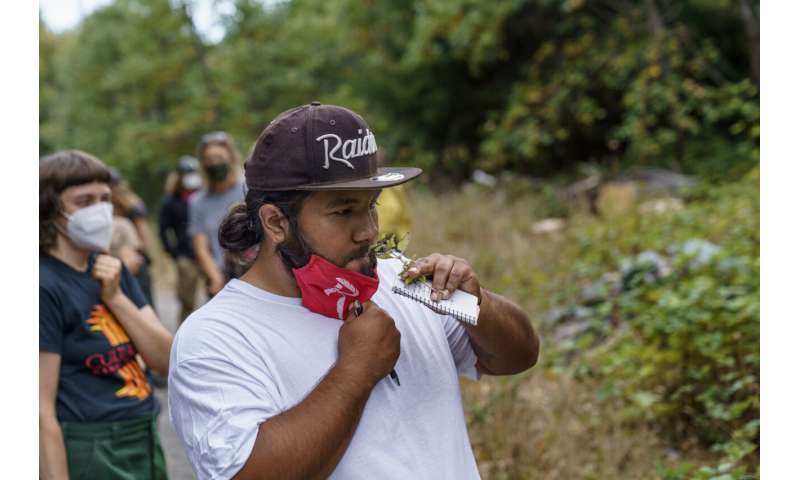
Stoney Timmons, a member of the Robinson Rancheria Pomo Indians, smells a lemon balm plant while scouting an area with fellow participants of a cultural training burn in Weitchpec, Calif., Tuesday, Oct. 5, 2021. Before they were outlawed, cultural burns enriched the land with berries, medicinal herbs and tan oak acorns while killing bugs. It opened browsing space for deer and elk. It let more rainwater reach streams, boosting salmon numbers. It spurred hazelnut stems and bear grass used for intricate baskets and ceremonial regalia. Credit: AP Photo/David Goldman -
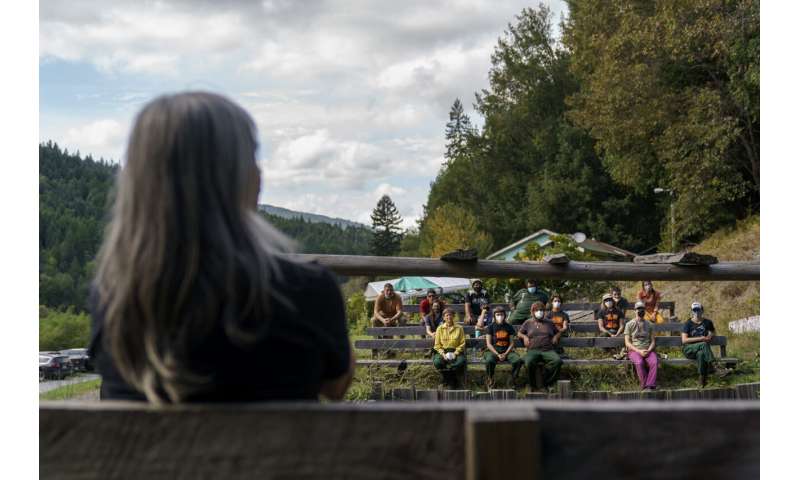
Margo Robbins, a member of the Yurok tribe, talks to participants of a cultural training burn as they visit a ceremonial dance pit in Weitchpec, Calif., Tuesday, Oct. 5, 2021. Robbins would become a leading the voice in the struggle to return fire to her people's ancestral territory, much of which is under state and federal management. Credit: AP Photo/David Goldman -
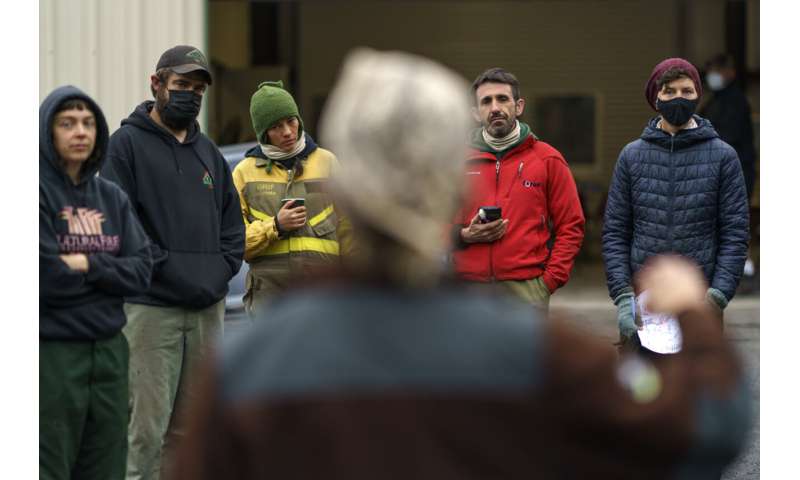
Jose Luis Dulce, center right, a firefighter in Ecuador and in his home country, Spain, listens during a briefing before a cultural training burn on the Yurok reservation in Weitchpec, Calif., Friday, Oct. 8, 2021. Dulce said he attended the training to help revive Indigenous techniques in Europe and South America. Credit: AP Photo/David Goldman -
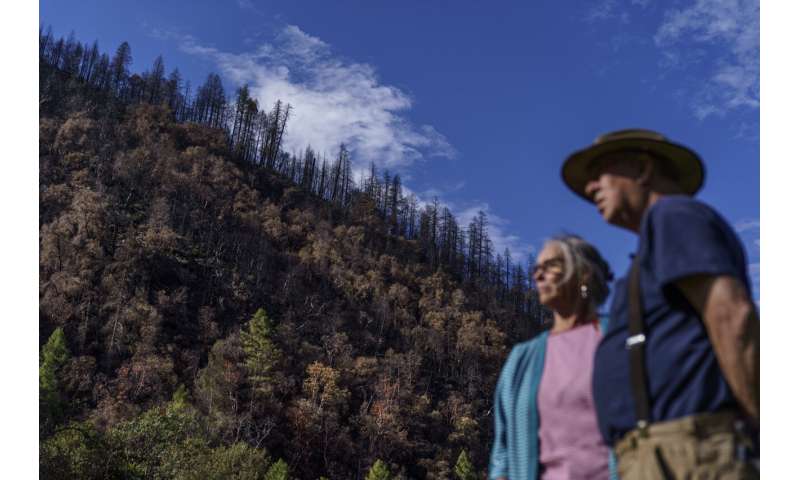
A scorched hillside rises from the backyard of Ruth, 72, and John Bain, 76, a member of the Karuk tribe, where last year's Slater Fire destroyed a house and several antique cars on their property in Happy Camp, Calif., Wednesday, Oct. 6, 2021. "They can get rid of the brush and that will save a bigger fire down the road, probably," said John. "It's gonna help because that's all going to come back in two or three years as just brush and if they can keep that under control, it could stop a big fire. I think the tribe should do it and the Forest Service should do it too." Credit: AP Photo/David Goldman -
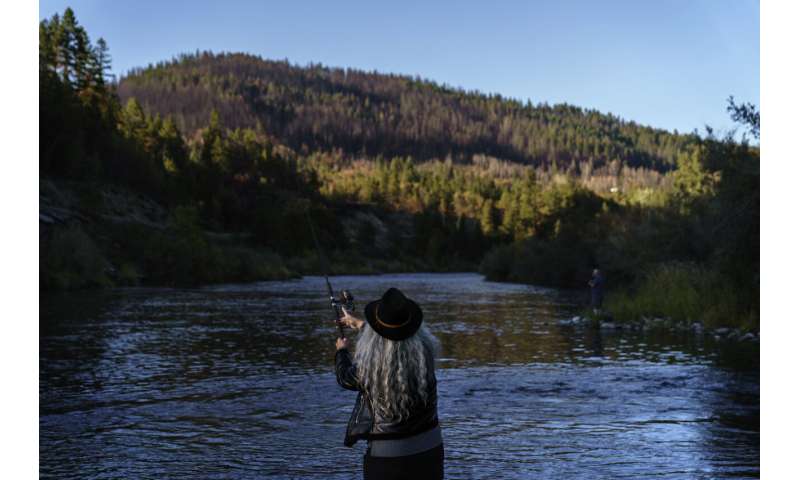
A woman fishes in the Klamath River as a mountain which burned in last year's Slater Fire stands in the background in Happy Camp, Calif., Wednesday, Oct. 6, 2021. Wildfires have blackened nearly 6,000 square miles (15,540 square kilometers) in California the past two years and more elsewhere amid prolonged drought and rising temperatures linked to climate change. Dozens have died; thousands of homes have been lost. Credit: AP Photo/David Goldman -
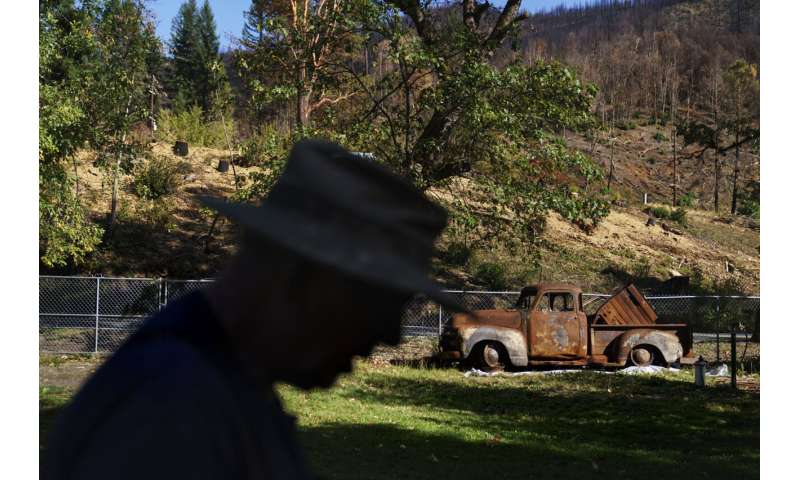
John Bain, 76, a member of the Karuk tribe, walks by his prized 1954 Chevy five-window pickup that was destroyed in last year's Slater Fire which tore through his property and the Klamath National Forest in Happy Camp, Calif., Wednesday, Oct. 6, 2021. "I never seen winds like that. I never thought it would do what it did," said Bain. "I lost my little two-bedroom house and my shop, car port, a 40-foot cargo container, and the barn shed and I had four pick-ups that burned up." Credit: AP Photo/David Goldman -
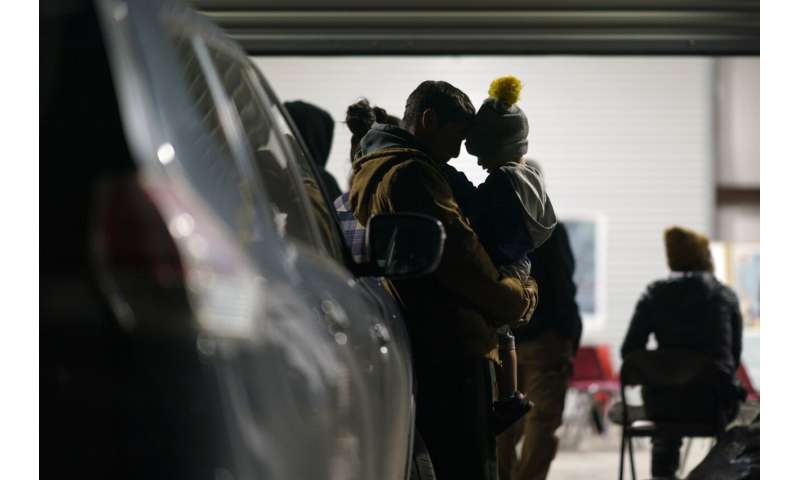
Talon Davis, 27, a member of the Yurok tribe, holds his son, Kenneth, 2, at the end of the day following a cultural training burn on the Yurok reservation in Weitchpec, Calif., Thursday, Oct. 7, 2021. Davis welcomed the opportunity "to show the world what good fire is." He added, "this is how we're supposed to care for Mother Earth. Put fire back on the ground, bring our home back into balance." Credit: AP Photo/David Goldman
The mid-Klamath area is ideal for a teaching center where cultural burners could "guide us into a new era of living with fire," said Tripp, who learned from his great-grandmother and was setting small blazes in his remote village by age 8.
Tribes are uniquely positioned to train younger generations about stewardship-oriented fire management, said Scott Stephens, an environmental policy professor at the University of California, Berkeley.
"We'd need literally thousands of people doing this burning to ramp it up to a scale that's meaningful," he said.
Talon Davis, 27, a member of the Yurok crew, welcomed the opportunity "to show the world what good fire is." He is Robbins' son-in-law; his own toddler has been carried in her baskets, as she wished.
"This is how we're supposed to care for Mother Earth," he said. "Put fire back on the ground, bring our home back into balance."
© 2021 The Associated Press. All rights reserved. This material may not be published, broadcast, rewritten or redistributed without permission.




















